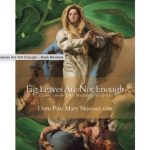A Review by Laura Rowe
26 November 2025
There are some topics currently being debated in both Christian and secular circles that have become so twisted and manipulated that it is difficult to obtain the truth on what is right and wrong. Modesty is one of those topics. It is hard to imagine what it must have been like to live in a world where there was almost a universal understanding, at least in the West, on what was appropriate attire and what was not. There was reliability in the outfits that women wore that they would be functional and beautiful, and assurance for men that they could safely step out of their front doors without the risk of immediately coming across an occasion for sin. We do not live in such a world anymore, but that does not mean that we should be accepting of the new standard of dress, and this is exactly what Dom Pius Mary Noonan explores in his book, Fig Leaves Are Not Enough: Open Letters on Modesty in Dress. In this book, he identifies the initial cause of the desire to both wear and observe immodest dress as our adoption of original sin, and seeks to encourage young women to overcome that sinful nature by dressing in a way that is mindful of God’s desires for young men and women. He begins with a discussion on the practice of veiling in church, followed by a deep-dive into the origins of immodesty of both dress and character, revealing that much of society’s desire to attract attention through the showing of skin is actually rooted in the sinful act of our first parents and thus the original sin that lives in us all.
This link throughout the book to original sin provides a juxtapositional element. It is frightening to think about how something as minor as the clothes we put on ourselves in the morning has links to the salvation of our souls, much like every other horrific act of sin that is committed in the world today. It magnifies the issue, which is perhaps the exact treatment it needs in order for Christians and churches today to take it more seriously than they currently are. However, understanding that the origins of this issue trace back to original sin also provides somewhat of a comfort. As destructive as immodesty in body and heart is, knowing that original sin has been conquered by the sacrifice of Christ means that so has immodesty. As prominent as it is in society, it has already been overcome, and that means we can look to the one who conquered it to show us how we may be defended from it.
Another critical element that Fr Noonan speaks to is the inclusion of male voices in the modesty debate. He confronts this in the first few pages of the book, stating that “men are the ones who are primarily affected by the way women dress.” We do rarely hear male perspectives on female modesty, largely, one would assume, as a result of the extreme backlash that well-intentioned men receive when speaking into topics that some radical feminists believe do not relate to them. Fr Noonan reveals here however that a woman’s modesty in dress does in fact relate to men. Due to the significant impact that women’s dress can have on a man’s physical and emotional responses, the way a woman dresses has a huge potential to be a stumbling block for our brothers in Christ. It is refreshing therefore to hear his brave voice and gain an understanding of what men feel about this issue and how we as women can assist them in the choices that we make. He elaborates on this further in the book, suggesting to women that “if you don’t revere your own body by covering it modestly, why would the men?” Critics of modesty will say that it is unfair that women must bear the ‘burden’ of dressing modestly as they are only doing it to protect the eyes and hearts of the men around them. Fr Noonan brings to light however the fact that we should have respect for our own bodies by virtue of it being ours. They have been given to us by God as temples of the Holy Spirit. We therefore have a duty to adorn it in a way that is pleasing to Him, instead of using it as a tool against our fellow brothers in Christ. He further highlights that by embracing modesty, we are able to emphasise our femininity, which will allow women to grow in virtue as the feminine characteristics of her body and mind can be fully realised, and will also allow men to step into their God-ordained role and enable their masculinity to thrive. He states that as the lines become more blurred between men and women by way of androgynous dress, femininity and masculinity also become intertwined with one another and therefore neither can truly stand out and fulfill its God-given potential. This is yet another reason as to why it is vital that these differences are recognised and encouraged.
The conclusion of this book may be one of the most encouraging perspectives on the topic today, despite the harrowing reality of the situation. His final charge to the reader is to follow what the church and the Bible teach as appropriate dress and to influence other women to do the same. Despite the enormous challenge that this appears to be, Fr Noonan reminds us that as the world was converted to Christianity by twelve men, perhaps all it takes is twelve women to change people’s hearts on modesty. Particularly when we feel that it is impossible to sway public opinion on the issue, we can be encouraged that historically, the ‘democracy of the dead’ tells us those in favour of modest dress far outweigh those against it, and as he put so beautifully, “only what is dead flows with the current”. We do not need to be held captive by the fashion trends of our modern era, we can hold firm to what is pleasing to God and what will create the most virtue and holiness in our lives.
This book says the things that nobody wants to say out loud, but what we all do want to hear. Young Catholic women in particular want clarity on what is right and wrong when the message currently propagating from the world (and even in some religious contexts) is so perverse. The world wants us to think that modesty is a grey area but it is not. It is black and white, just like everything else that Christ teaches us. I am thankful that ‘Amanda’ asked the questions we all ask, particularly in specific circumstances such as what to wear to the beach, playing sports and in the presence of our own husbands. It is truly reflective of the aspects of modesty that women struggle with and is therefore an accurate and useful book to help us find solutions. This in addition to the caring and non-judgmental tone of the letters truly provides the feel that Fr Noonan is directly addressing the reader and speaking to situations we have personally encountered. Furthermore, the extensive sources cited demonstrates the depth of research that has gone into this book and provides objective and empirical studies to support the claims that are made. These sources include research conducted on the impact of hookup culture on college campuses, high heels in work spaces, and the visual predisposition of the male brain, just to name a few. This takes his ideas entirely out of the ‘purely religious’ scope and applies it to society at large, making it true and applicable for all people.
If you want to read a text that cuts through the noise of the modesty discussion and provides clarity on what the biblical standard for dress is, as well as opening your mind to the psychological impact that immodesty is having on men and women today, this book is one to be read, pondered on and shared. Even for those who believe that they have an acceptable understanding of this topic, prepare to be challenged even further and to re-examine your own standards, even your own wardrobe! If the knowledge shared in this book was made more apparent to our society, it is very possible that we would see a radical shift in the right direction. So, read this book, apply its wisdom to your own life, and then find someone who will be willing to do the same. If there is one important thing to take away from Fig Leaves Are Not Enough it is that we as Catholics are given the colossal charge to return the state of dress to its most glorifying manner, and Christ gives us the tools to make it possible.










